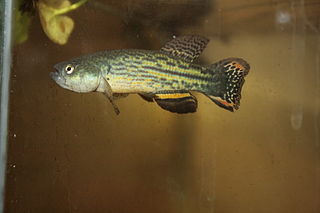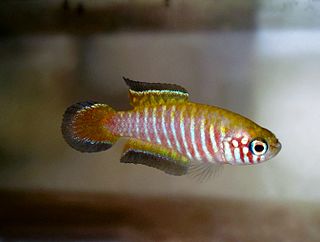
The Rivulidae are a family of killifishes in the order Cyprinodontiformes. They are commonly known as rivulids, South American killifish or New World killifish. The latter names are slightly misleading, however, as they are neither restricted to South America – though most are in fact found there –, nor are they the only killifishes from the Americas. Occasionally, they are still referred to as rivulines, a term dating back to when they were considered a subfamily of the Aplocheilidae.
The marbled pearlfish is a species of killifish in the family Rivulidae. This threatened species is found in temporary channels within dense Atlantic rainforest, in the floodplains of rivers draining into the Baía de Guanabara, near the city of Rio de Janeiro in southeastern Brazil. It reaches up to 3 cm (1.2 in) in total length.

Leptolebias opalescens, also known as the opal pearlfish is a species of killifish in the family Aplocheilidae endemic to Brazil. This species was described as Cynolebias opalescens by George S. Myers in 1942 with the type locality given as the base of the Serra do Petrópolis, near Imbarié in the municipality of Duque de Caxias, Rio de Janeiro.
Leptolebias splendens, also known as the Splendid pearlfish is a species of killifish in the family Rivulidae endemic to Brazil, in the vicinity of Rio de Janeiro. This species was described as Cynolebias splendens in 1942 by George S. Myers with the type locality given as water holes or ponds along the foot of the Serra de Petropolis in Rio de Janeiro State. Deforestation and urbanisation led to the species disappearance from the area of its type locality and it was thought to be extinct but it was rediscovered 5 kilometres (3.1 mi) from the type locality some 70 years after the last known previous record.
Austrofundulus is a genus of killifish in the family Rivulidae native to northern Colombia, northern Venezuela and southwestern Guyana. They are annual killifish where adults generally have a short life in temporary ponds or swamps and the eggs experience a period of drought, only hatching when again covered by water.

Austrolebias is a genus of killifish in the family Rivulidae. These annual killifish live in temporary pools, swamps and streams in the Río de la Plata, Patos–Mirim and Mamoré basins in South America.
Maratecoara is a genus of killifish in the family Rivulidae. These annual killifish are endemic to seasonal pools, swamps and lagoons in the upper Araguaia–Tocantins and middle Xingu river basins in Brazil. Most are from savanna regions, but M. gesmonei is from the Amazon rainforest.

Melanorivulus is a genus of South American freshwater fish in the family Rivulidae. Most species are endemic to the Río de la Plata, eastern Amazon, Tocantins–Araguaia and São Francisco basins in Brazil, but a few members of this genus range west into Bolivia, south into Paraguay and Argentina, and east to Parnaíba and Sergipe in northeastern Brazil. Only M. schuncki occurs north of the Amazon River. They inhabit shallow waters, generally 5–30 cm (2–12 in) deep, at the margins of streams in open or fairly open habitats like the Cerrado or Cerrado–Amazon transition. Many have tiny ranges and are seriously threatened.

Anablepsoides is a genus of killifish in the family Rivulidae native to tropical South America and the Lesser Antilles. The majority are from the Amazon and Orinoco basins, as well as freshwater systems in the Guiana Shield, but a few species are from northern Venezuela, northeastern Brazil and the Lesser Antilles. Although largely restricted to lowlands, a few species occur in the lower East Andean foothills. They are mostly found in shallow fresh water swamps, streams, edges of rivers, ponds and pools, but a few may occur in brackish estuaries. They are able to jump over land and breathe air for short periods, allowing them to access isolated waters inhabited by few or no other fish. Several Anablepsoides species have small distributions and some are seriously threatened by habitat loss; the entire known range of A. xinguensis is in the area flooded by the Belo Monte Dam.
Moema is a genus of fish in the family Rivulidae. These annual killifish are mostly restricted to the Amazon basin in Bolivia, Brazil and Peru, but a few inhabit the upper Essequibo basin in Guyana, upper Orinoco basin in Venezuela and upper Paraguay basin in Brazil. They inhabit temporary waters, such as swamps or ponds, in primary forests. Once the water disappears, the adults die, but the eggs that have been laid in the bottom remain, only hatching after 3–10 months when the water returns. They rapidly reach adult size, but generally only live a few months after hatching, although captives can live longer.
Nematolebias is a genus of fish in the family Rivulidae. These threatened annual killifish are endemic temporary waters, like pools, in the Atlantic Forest in Rio de Janeiro state, Brazil.

Neofundulus is a genus of fish in the family Rivulidae. These annual killifish are endemic to the Paraguay, Guaporé, Mamoré and São Francisco basins in Argentina, Bolivia, Brazil and Paraguay. They inhabit temporary waters, such as swamps or ponds, that typically are located in open habitats like grassland. Once the water disappears, the adults die, but the eggs that have been laid in the bottom remain, only hatching after several months when the water returns.
Notholebias is a genus of fish in the family Rivulidae. These threatened annual killifish are endemic temporary waters, like ponds, in the Atlantic Forest in Rio de Janeiro state, Brazil.
Pterolebias is a genus of killifish from the family Rivulidae which are native to temporary swamps and ponds in South America. It includes two groups, which sometimes are regarded as separate genera: Pterolebias from the southern Amazon and Paraguay river basins, and Gnatholebias from the Orinoco river basin.
Rachovia is a genus of killifish from the family Rivulidae the species of which are endemic to the Orinoco, Maracaibo and Magdalena basins in Colombia and Venezuela, where they live in small temporary waters like ponds. They are small annual killifish that reach up to 6 cm (2.4 in) in total length. The name of this genus honours the German aquarist Arthur Rachow (1884-1960) who sent fish specimens to George S. Myers.

Simpsonichthys is a genus of killifish from the family Rivulidae the species of which are endemic to temporary freshwater habitats like ponds in the upper Paraná, upper Araguaia, upper Jequitinhonha and São Francisco basins on the central Brazilian Plateau. They are small annual killifish that reach up to 5.5 cm (2.2 in) in standard length.
Xenurolebias is a genus of fish in the family Rivulidae. These annual killifish are endemic to temporary pools in the Atlantic forest near the coast in southeast Bahia and Espírito Santo, Brazil.

Simpsonichthys constanciae is a species of killifish from the family Rivulidae that is endemic to Brazil. It is restricted to temporary freshwater habitats in the São João basin in Rio de Janeiro, while all other species in the genus are from Bahia. It is a small killifish that is up to 6 cm (2.4 in) in total length.

Spectrolebias is a genus of killifish in the family Rivulidae. These annual killifish are endemic to seasonal waters in the Paraguay, Tocantins–Araguaia, Xingu and Mamoré–Grande basins in Bolivia, Brazil and Paraguay. Each species generally has a small distribution and some are seriously threatened by habitat loss; the entire known range of S. reticulatus is in the area flooded by the Belo Monte Dam.

Leptopanchax is a genus of small fish, up to 5 cm (2.0 in) long, in the family Rivulidae. They are found in southeastern Brazil from Paraná to Rio de Janeiro. Depending on the exact species, they inhabit small seasonal channels in the Atlantic rainforest or temporary pools in open habitats. Several Leptopanchax species are very rare and L. sanguineus is possibly extinct.










